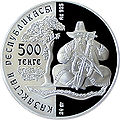Category:Kobyz
ancient Turkic bowed string instrument | |||||
| Upload media | |||||
| Subclass of | |||||
|---|---|---|---|---|---|
| Country of origin | |||||
| Different from | |||||
| |||||
Kobyz (or kyl-kobyz; In Kazakh: қобыз) is an ancient Kazakh en:string instrument. It has two strings made of horsehair. The resonating cavity is usually covered with goat leather.
In the 1930s, when the first folk instrument orchestras were established in the Soviet republic of Kazakhstan, a new kind of kobyz came into existence. It now had four metallic strings and thus became closer to a violin.
For similar shaped instruments, see Ghaychak (Persia), Kobyz (Kazakhstan), Kyl kyyak (Kyrgyzstan), Sarinda (India & Nepali), Dhodro banam (Santhals in East India) Sarangi (Nepali), etc.
Both JPEG and PNG formats can be loaded together.
See: Discussion about JPEG and PNG format files in Russian.
Discussion about JPEG and PNG format files in English.
Media in category "Kobyz"
The following 22 files are in this category, out of 22 total.
-
Coin of Kazakhstan 0143.jpg 292 × 292; 87 KB
-
Coin of Kazakhstan 0144.jpg 1,055 × 1,054; 966 KB
-
Kazakhstan postage stamp depicting a Kobyz.png 334 × 394; 167 KB
-
Kazhakhstan a Paris.Turan ensemble.2.jpg 712 × 461; 121 KB
-
Kobyz (musée Guimet) (5365308326).jpg 720 × 1,080; 239 KB
-
Kobyz, Makarov (2023-04-12) 01.jpg 3,864 × 5,152; 5.9 MB
-
Kobyz, Makarov (2023-04-12) 02.jpg 3,864 × 5,152; 5.83 MB
-
Kobyz, Makarov (2023-04-12) 03.jpg 3,864 × 5,152; 5.91 MB
-
Kobyz, Makarov (2023-04-12) 04.jpg 3,864 × 5,152; 5.81 MB
-
Kobyz.jpg 349 × 264; 23 KB
-
Mongorian musical instruments, MIM PHX.jpg 2,924 × 1,876; 1.46 MB
-
Musical instruments on display at the MIM (14351816715).jpg 459 × 640; 58 KB
-
Phoenix-Musical Instrument Museum-Mongolia exhibit.jpg 3,264 × 2,448; 1.94 MB
-
Stamp of Kazakhstan 434.jpg 334 × 394; 20 KB
-
Stamp of Kazakhstan kz628-9sh.jpg 420 × 343; 30 KB
-
Turan.Maxat Medeubek.kobyz.Қобыз.库布孜.jpg 2,486 × 4,085; 2.16 MB
-
Көне қобыз.jpg 3,096 × 4,128; 1.86 MB






















